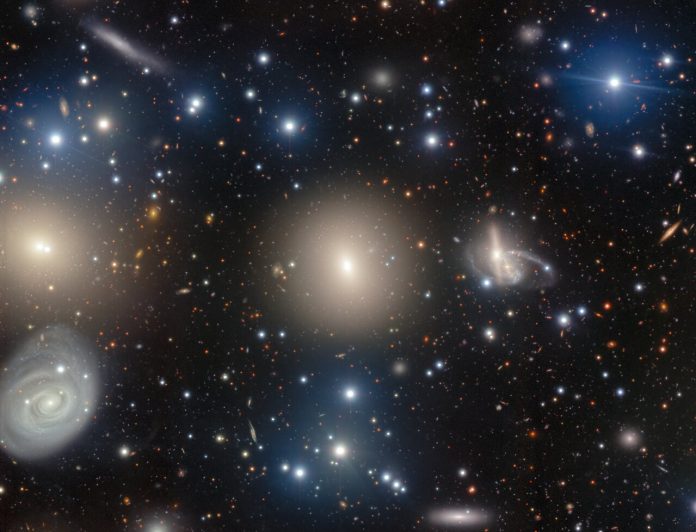
The elliptical galaxy NGC 1270 lies about 240 million light-years away.
But it’s not alone.
It’s part of the Perseus Cluster (Abell 426), the brightest X-ray object in the sky and one of the most massive objects in the Universe.
NGC 1270 plays a starring role in a new image from the Gemini North telescope.
However, the image doesn’t show the dark matter that has a firm grip on the galaxy and the rest of the galaxies in the Perseus Cluster.
Ancient astronomers would be astounded by what we’ve learned about the Universe. Even astronomers like Edwin Hubble from the 20th would be amazed at the power of our modern telescopes and what they’ve shown us.
At that time, distant galaxies appeared fuzzy and were called nebulae.
Even the nature of Andromeda, our closest galactic neighbour, was uncertain. In 1920, Hubble and others were debating whether Andromeda and other objects they were seeing were small objects in the Milky Way’s outer regions, nebulae, or other galaxies.
German philosopher and Enlightenment thinker Immanuel Kant coined the term ‘island Universes’ to describe all these fuzzy objects, hinting at their true nature.
The idea of other galaxies beyond our own dates back a long way, but there was no way to test it. Then, in 1924, Edwin Hubble ended the debate. He was able to show that individual stars in some of these so-called “nebulae” were actually far beyond the Milky Way.
The discovery was decisive, and we now know that the Universe is populated by hundreds of billions or even trillions of other galaxies like our own Milky Way.
Now, astronomers use powerful telescopes to examine other galaxies in great detail. They’ve even used the James Webb Space Telescope to peer back in time at the Universe’s earliest galaxies. Anyone can quickly examine hundreds of amazing images of other galaxies of all types.
Enormous objects like the Perseus Cluster alert us to the presence of something even more mysterious and challenging to understand than the nature of galaxies. Something binds these individual galaxies together into a coherent group, and we call that dark matter.
There’s a growing chorus of scientific voices suggesting we stop calling it dark matter and instead use the more accurate term invisible matter. But whatever we decide to call it, dark matter makes up most of the matter in the Universe and dwarfs the “normal” matter that interacts with light and makes up stars, planets, and us.
As cosmology has progressed, scientists have mapped the universe’s large-scale structure. These maps show how galaxies and their groups are organized along filaments of dark matter that act as scaffolds. The Perseus Cluster is associated with the Perseus-Pegasus Filament, a long, thin structure of galaxies that stretches over a billion light-years.
If there were no dark matter, scientists think that the Universe would be far more homogenous. The galaxies would be spread more evenly throughout space. But that’s not what we see, and NGC 1270 and the rest of the Perseus Cluster show it clearly.
Currently, scientific theory suggests that a web of invisible dark matter draws galaxies together. They’re situated where dark matter’s massive tendrils intersect. That’s where its gravitational pull is strongest.
In short, the Perseus Cluster and NGC 1270 wouldn’t be where they are and wouldn’t be grouped together without dark matter. The cluster, and all other groups, clusters, and super-clusters, are firmly in dark matter’s grip.
American astronomer Vera Rubin played a huge role in our modern understanding of dark matter. She observed that stars and gas at a galaxy’s outer edge were moving much faster than predicted by the visible mass of the galaxy.
Newtonian physics suggests they should be moving slower. Rubin and her colleagues thought that there must be a large amount of invisible matter beyond the visible edges of galaxies. Eventually, she figured out that there must be six times more dark matter than visible matter in galaxies.
Rubin faced many obstacles in getting her results accepted. As a woman, she wasn’t part of the male-dominated world of 1970s astronomy. She was denied access to some facilities early in her career, which slowed her progress.
Now, she’s given full credit and mentioned alongside Hubble and other influential figures in astronomy. One of the most powerful and unique observatories ever conceived is named after her.
Regardless of what we call it and who discovered it, our Universe is dominated by something we don’t fully understand.
It’s remarkable that scientists can map invisible matter by its inference alone, without knowing what it is. The most widely accepted understanding of dark matter is in the Lambda Cold Dark Matter (Lambda-CDM) model of cosmology, also called the Standard Model of Big Bang Cosmology.
It successfully recreates many things that we observe in the Universe, including how galaxies form, how the Universe expands, and, of course, the large-scale structure of the Universe.
But even Lambda-CDM can’t tell us what dark matter is. Most think it’s some type of particle, but if it is, it’s extremely elusive.
That doesn’t stop us from seeing its effect when we observe objects like NGC 1270 and the Perseus Cluster.
Written by Evan Gough/Universe Today.



